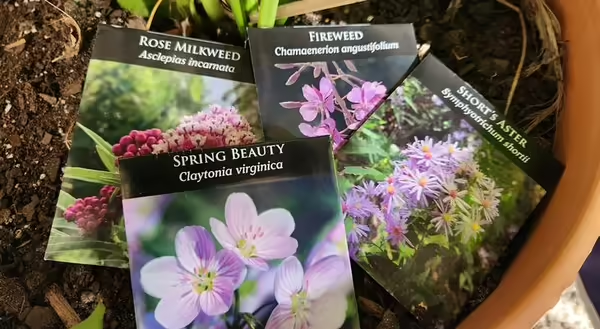
Winter sowing is a cost-effective and low maintenance way of starting plants for the garden. The creator of the winter sowing method, Trudi Davidoff puts it in simple terms, "starting plants outdoors, in winter."
Winter sowing works with nature to prepare seeds for growth by providing the proper conditions to begin germination. While this may sound complicated, the only supplies needed are soil, seeds, and semi-transparent recycled containers.
Prepare proper containers
To begin, create your miniature greenhouse from recycled plastic containers. Milk jugs that allow light to penetrate work well. Experiment with the recyclable containers you have on hand.
Because the containers will collect snow and rain, cut drainage holes into your mini-greenhouse. With a drill or utility knife, cut several holes into the bottom of the container. Adding three holes on each side of the milk jug increases drainage. Cut around the milk jug just below the bottom of the handle. Leave about ½ inch intact just below the handle. This section acts as a hinge to hold the container together.
Add soil and water
Next, fill the bottom of the miniature greenhouse with soil about three to four inches. Moisten the soil and allow it to drain. The soil should have a moisture level like a damp sponge. Light and fluffy soil that drains well works the best.
Plant proper types of seeds
The container is now ready for seeds. Leave small seeds on top of the soil. Follow the instructions on the seed packet for planting depths of larger seeds. Make sure there is good contact between the seed and the soil. Replace the lid and secure with duct tape. Label the container with the date and the type of seed planted. Your small greenhouse container is ready to go outdoors.
Find the best location for mini-greenhouse
Place the container in an area that is safe from strong winds. The mini-greenhouses should get sunlight and have exposure to rain and snow. Now let nature do its work. The temperature variation prepares the seeds for germination at the proper time.
Maintain mini-greenhouse as temps warm
When the days begin to warm, seedlings will emerge. Open the container on sunny days but close it at dusk to protect the seedlings from cold night temperatures. The seedlings naturally harden off and can be transplanted when soil temperatures are at proper levels.
Cut flaps along the side of the miniature greenhouse to slide seedlings out. Divide the clump into pieces and plant as you would a store variety.
Wait to begin winter sowing until January or February. If there is a warm spell, the seeds can germinate but won't be hardy enough to survive when temperatures fall. Do your homework when choosing seeds. Frost tolerant flowers and vegetables such as petunias, cosmos, kale, broccoli, spinach, and Brussel sprouts withstand the cold temperatures of early winter. Frost sensitive species such as zinnias, tomatoes, squash need to wait until the warmer temperatures of March or April to start.
Winter sown seedlings grow into healthy, sturdy plants; plants ready to thrive in the garden.